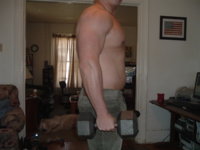Do you really want me to go into detail about that...ok, you asked for it. This is a link to the full-text study explaining the glucose shuttling effects of DNP.
http://ajpcell.physiology.org/cgi/content/full/275/6/C1487
Here's the discussion info:
Distinct pathways for glucose transport stimulation. Several lines of evidence suggest that a pathway exists for the stimulation of glucose transport into skeletal muscle by insulin that differs from that for stimulation of energy demand (contraction or hypoxia). For example, a combination of the two stimuli produces an additive stimulation of glucose uptake. Furthermore, insulin signaling requires activation of PI3K and Akt/PKB, but hypoxia and contraction do not (
40,
43,
57). Here we show that the stimulation of glucose uptake by DNP in L6 muscle cells is additive to that induced by insulin. Also, we demonstrate that, unlike insulin, DNP does not activate PI3K, Akt/PKB, or p70S6K. The lack of activation of Akt/PKB by DNP is in agreement with the recent study by Lund et al. (
43) that showed muscle contraction had no effect Akt/PKB activity. These findings support the notion that at least two distinct pathways leading to the stimulation of glucose uptake also exist in L6 muscle cells. The insulin-independent pathway will hence be termed "the alternative pathway" for the purpose of this discussion.
The Ca2+-PKC hypothesis. It has long been considered that the rise in intracellular Ca2+ is a critical mediator of increased glucose transport during skeletal muscle contraction and hypoxia (
7,
25). This has been proposed mostly on the basis of inhibition of the stimulation of glucose transport during hypoxia and contraction by agents that are thought to block Ca2+ channels [e.g., verapamil (
7)] or lower Ca2+ efflux from the sarcoplasmic reticulum [e.g., dantrolene (
25)]. Additionally, several studies have shown that rates of glucose transport can be increased in mammalian muscle when cytoplasmic Ca2+ concentrations are raised using agents such as W-7, caffeine, and Ca2+ ionophores (
24,
25,
47). In contrast, insulin does not significantly affect cytosolic Ca2+ levels (
33,
35). Ca2+ is, however, released from mitochondria as a result of DNP dissipation of the H+ gradient (
44). We therefore reasoned that Ca2+ may be a trigger in the insulin-independent mechanism of glucose transport activation. Our findings with the buffering of intra- and extracellular Ca2+ provide more direct evidence that Ca2+ plays a significant role in the stimulation of glucose transport induced by DNP but not in stimulation induced by insulin.
A rise in cytoplasmic Ca2+ levels may facilitate the activation of key intracellular signaling molecules that lead to increased muscle glucose transport. PKC is a Ca2+-dependent signaling intermediary that can be activated by increases in cellular Ca2+. Because Ca2+ can activate cPKCs and PMA (a known activator of cPKC) can increase glucose by a transport mechanism distinct from insulin (
2,
18,
36,
58), we explored the potential role of cPKC in DNP-stimulated glucose transport. On the basis of four lines of evidence, we propose that DNP, acting through Ca2+-sensitive PKC, can modify L6 muscle cell glucose transport.
1) The downregulation of cPKC, but not of atypical PKC protein isoforms, decreased DNP-stimulated glucose transport by 45%, with no effect on insulin-induced glucose uptake.
2) The DNP-induced rise in glucose transport was lowered by 60% with a low dose of BIM (1 µM) that is known to effectively inhibit cPKC, whereas the insulin response was only affected at a far greater BIM concentration.
3) DNP caused a rapid translocation of PKC-
, -
, and -
to the cell surface and brought about their activation. It is conceivable that, in addition to Ca2+ activation, the kinase molecules experienced covalent modifications that contributed to this activation.
4) Using 379196 to selectively inhibit PKC-
, we observed a partial decrease (67%) in the stimulation of glucose transport by DNP, which closely approximates the inhibition observed with BIM treatment (60%). Therefore, we propose that PKC-
may account for the cPKC isoform participating in glucose transporter mobilization during metabolic challenge. Previous reports have revealed PKC activation during muscle contraction (
12,
50). However, which of the 12 different PKC isoforms was responsible for this effect was not determined. In light of our findings with 379196, it is plausible that PKC-

may also relay the signal to glucose transporters in the exercising muscle. If specific antagonists for the other Ca2+-sensitive PKC isotypes become available, it will be possible to verify the specific cPKC mediators of the alternative mechanism of glucose transport activation. Because PMA-stimulated glucose transport was completely inhibited by 1 µM BIM and PMA downregulation of cPKC and yet no more than 60% of the stimulation by DNP was inhibited by these manipulations, we postulate that there may be a PKC-independent component to the stimulation of glucose uptake by DNP. Conversely, PMA stimulates cPKC activity by eightfold but is only able to induce a 50% rise in glucose transport. Therefore, robust activation of PKC alone is not sufficient to increase glucose transport to levels comparable to those induced by DNP or insulin. Discrepant effects of phorbol esters, insulin, and hypoxia on glucose transport have been noted previously (
18,
20,
58). Ca2+ chelation was more effective than cPKC inhibition in reducing the DNP stimulation of glucose uptake. However, even this treatment left a residual increase in glucose uptake. Also, the effect of Ca2+ buffering on DNP action was not enhanced by simultaneous cPKC inhibition or cPKC deletion (Table
1). Assuming that all treatments were fully effective on their targets (i.e., they fully inhibited cPKC and prevented rises in cytoplasmic Ca2+, as appropriate), then it is possible that three types of signals cooperate to bring about the DNP effect on glucose uptake: cPKC activation, a secondary effect of Ca2+, and a Ca2+-independent signal.
This concept is illustrated in
Fig.
10.
 View larger version
View larger version (51K):
[in a new window]
Fig. 10. Ca2+- and cPKC-dependent components of DNP-stimulated glucose transport. Whole pie graph represents 100% of glucose transport stimulated by DNP. Hatched and stippled regions represent Ca2+-dependent component (80%) of this activation. Within this Ca2+-dependent element, we postulate that 60% of DNP response (stippled region) is mediated by cPKCs that are sensitive to intracellular Ca2+ levels (likely PKC-
). Remaining Ca2+-independent component (~20%, open region) involves unknown mediators.
Using L6 GLUT-4-myc cells, we were able to show that the inhibition of DNP-stimulated 2-[3H]deoxyglucose uptake caused by Ca2+ chelation or by interference with cPKC activation is reflected by a decrease in the mobilization of GLUT-4-myc to the cell surface. GLUT-4-myc translocation, assessed by a colorimetric detection assay, was impaired by these manipulations to nearly the same extent as glucose transport in wild-type L6 or L6 GLUT-4-myc muscle cells. It was shown previously that the GLUT-4-myc expressed in L6 myotubes is functional for glucose uptake and behaves like endogenous GLUT-4 (
31,
59). Therefore, the inhibitory effect of cPKC inhibition or downregulation and Ca2+ buffering on DNP-stimulated glucose transport occurred at a signaling step proximal to GLUT-4 translocation rather than at the level of GLUT-4 vesicle docking and fusion or by a direct effect on glucose transporter activity. Consistent with a role for PKC stimulation of GLUT-4 vesicle translocation, numerous early studies report that agents that activate PKC can stimulate exocytosis in a variety of cell types (
26,
28). Billiard et al. (
6) observed that the exocytosis of secretory vesicles in rat pituitary gonadotropes could be stimulated independently by either Ca2+ elevations or PKC activation with PMA. Because the stimulation of glucose uptake by DNP involves incorporation of GLUT-containing vesicles into the cell surface (
57), the participation of cPKC in this step is a distinct possibility.
Other potential mediators. The alternative pathway appears to involve Ca2+-dependent and Ca2+-independent signals, since Ca2+ chelation could not fully inhibit DNP-stimulated glucose transport. From our studies, the origin and nature of the Ca2+-independent pathway is not evident, but it does not include the type 1A PI3K-Akt axis or other wortmannin-sensitive PI3Ks. This pathway probably also does not include PKC-
, since inhibition of all known subfamilies of PKC with 10 µM BIM did not further inhibit DNP-stimulated glucose transport even though it reduced insulin-stimulated glucose transport, which has been linked in part to a requirement for PKC-
(
2,
3) (Fig.
4A). It is noteworthy that activation of PKC-
by insulin probably occurs via PI3K lipid products (
2,
54).
A major unresolved issue is whether other signaling molecules, in addition to cPKC, are responsible for mediating the effect of DNP on glucose transport. Recently, it was proposed that 5'-AMP-activated protein kinase (AMPK) may be involved in hypoxia- or exercise-stimulated glucose transport but not in the insulin-dependent pathway (
22,
52). Given that metabolic stressors such as DNP are known activators of AMPK, we tested this hypothesis by chemically activating AMPK with the AMP analog 5-aminoimidazole-4-carboxamide ribonucleoside (AICAR). Maximal AICAR-stimulated glucose transport was not additive to insulin- or DNP-dependent glucose uptake in L6 muscle cells (Khayat and Klip, unpublished observations). Therefore, the participation of AMPK in the action of DNP on glucose transport is not likely. Other signals proposed to lead to glucose transport stimulation during muscle contraction are nitric oxide (NO) (
51) and bradykinin, acting through the trimeric G protein Gq (
31). Whether these signals are implicated in DNP action is not presently known. Goodyear et al. (
19) have shown that exercise, a physiological stressor, can activate the stress-activated mitogen-activated protein kinase (MAPK) p38MAPK in rat skeletal muscle. Similarly, we have shown rapid phosphorylation of p38MAPK by DNP in L6 muscle cells (
55). However, DNP-stimulated glucose uptake is likely not dependent on p38MAPK activity, since the selective p38MAPK inhibitor SB-203580 failed to prevent the DNP response of glucose transport (Khayat and Klip, unpublished observations). Three recent studies have used two chemical conditions that stimulate glucose transport independently of insulin signals to elucidate the molecular mechanisms underlying these distinct pathways. These are hyperosmolarity and guanosine 5'-
O-(3-thiotriphosphate) (GTP
S). In 3T3-L1 adipocytes, osmotic shock- and GTP
S-mediated elevations in GLUT-4 translocation are PI3K independent but are prevented by inhibitors of tyrosine kinases (
10) or by microinjection of anti-phosphotyrosine antibodies (
16,
21), suggesting that as yet unidentified tyrosine kinases may be activated by these stimuli and participate in glucose transport stimulation. In a previous study, we reported that treatment of L6 cells with DNP does not alter the pattern of tyrosine-phosphorylated proteins of myotube lysates assayed by immunoblotting with phosphotyrosine-specific antibodies (
57). Indeed, we have tested three structurally unrelated tyrosine kinase inhibitors, erbstatin (30 µg/ml), genistein (50 µM), and herbimycin A (50 µM), for inhibitory effects on DNP-stimulated glucose transport. None were able to reduce the DNP stimulation of 2-deoxyglucose uptake (DNP, 100%; DNP + erbstatin pretreatment, 93.4%; DNP + herbimycin A pretreatment, 89.2%; DNP + genistein pretreatment, 89.5%), whereas insulin-dependent glucose uptake was blocked by all three agents (Khayat and Klip, unpublished results). Therefore, it is not likely that mitochondrial uncoupling engages tyrosine kinase signaling pathway(s) similar to those of these other activators of glucose transport. In summary, the findings presented suggest that DNP may employ Ca2+ as a secondary messenger to activate cPKCs, forming part of the alternative signaling system leading to the regulation of glucose transport by energy demand in L6 muscle cells. This alternative pathway functions independently of the PI3K signaling pathway utilized by insulin to increase muscle cell glucose influx.





